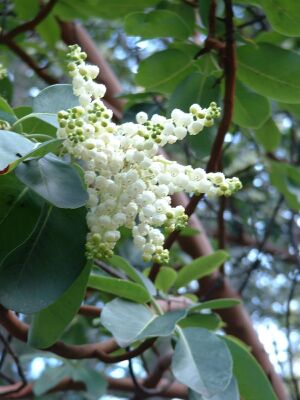- Pacific Madrone
Taxobox
name = Pacific Madrone

regnum =Plantae
divisio = Magnoliophyta
classis =Magnoliopsida
ordo =Ericales
familia =Ericaceae
genus = "Arbutus "
species = "A. menziesii"
binomial = "Arbutus menziesii"
binomial_authority = PurshThe Pacific Madrone ("Arbutus menziesii"), is a species of
arbutus found on the west coast ofNorth America , fromBritish Columbia (chieflyVancouver Island ) toCalifornia , mainly in thePacific Coast Ranges but also scattered on the west slope of the Sierra Nevada mountains. It becomes rare south ofSanta Barbara County , with isolated stands south toPalomar Mountain ,San Diego County and northernBaja California ,Mexico . It is also known as the madroño, madroña, bearberry, or strawberry tree. In British Columbia it is simply referred to as arbutus. Its species name was given it in honour of the Scots naturalistArchibald Menzies who noted it duringGeorge Vancouver 's voyage of exploration.It is a broadleaf evergreen tree with rich orange-red bark that peels away on the mature wood, leaving a greenish, silvery appearance that has a satin sheen and smoothness. The exposed wood sometimes feels cool to the touch. In spring, it bears sprays of small bell-like flowers, and in autumn, red berries. The berries dry up and have hooked barbs that latch onto larger animals for migration. It is common to see madrones of about 10-25 meters in height, but in the right conditions the trees reach up to 30 m. In best conditions madrones can also reach a thickness of 5-8 feet at its trunk, much like an
oak tree. The leaves are thick, oval, 7-15 cm long and 4-8 cm broad, and arranged spirally; they are glossy dark green above and a lighter, more grayish green beneath, with an entire margin. The leaves brown during the fall season and detach from the branches.Native American people ate the berries, but because the berries have a high
tannin content and are correspondingly astringent, they more often either chewed them or made them into a cider. Manymammal andbird species feed off the berries, includingAmerican Robin s,Cedar Waxwing s,Band-tailed Pigeon s,Varied Thrush es,Quail ,Mule Deer ,Raccoon s,Ringtail s, andBear s. Mule Deer will also eat the young shoots when the trees are regenerating after fire. It is also important as a nest site for many birds, and in mixed woodland it seems to be chosen for nestbuilding disproportionately to its numbers. The timber distorts during drying and is not much used, but an attractiveveneer can be made from it. Recently, it has become more popular in the Pacific Northwest as a flooring material, due to the durability of the wood, and the warm color after finishing. Mostly the wood is sought for its heating capabilities since it burns long and hot in fireplaces.Although
drought tolerant and relatively fast growing, the Pacific Madrone is currently declining throughout most of its range. One likely cause is fire control: under natural conditions, the madrone depends on intermittent naturally occurring fires to reduce theconifer overstory. Mature trees survive fire, and can regenerate more rapidly after fire than theDouglas fir s with which they are often associated. They also produce very large numbers of seeds, which sprout following fire. Since the arrival of Europeans in North America, fire suppression has resulted in a reduction of the range of the Pacific Madrone.Increasing development pressures in Pacific Madrone habitat have also contributed to a decline in the number of mature specimens. This tree is extremely sensitive to alteration of the grade or drainage near the root crown. Until about 1970, this phenomenon was not widely recognized on the west coast; thereafter, many local governments have addressed the necessary protection of Pacific madrone by stringent restrictions on grading and drainage alterations when madrone are present. The species is also affected to a small extent bysudden oak death , a disease caused by the fungus "Phytophthora ramorum".Cultivation
The Pacific Madrone is difficult to transplant and a seedling should be set in its permanent spot while still small. Transplant mortality becomes significant once a madrone is more than one foot (30 cm) tall. The site should be sunny (south or west-facing slopes are best), well drained, and lime-free (although occasionally a seedling will establish itself on a shell midden). Pacific Madrone needs no extra water or food in its native range once it has become established. Water and
nitrogen fertilizer will boost its growth, but at the cost of making it much more susceptible to disease.External links
* [http://ucjeps.berkeley.edu/cgi-bin/get_JM_treatment.pl?Arbutus%20menziesii Jepson Flora Project: "Arbutus menziesii"]
* [http://plants.usda.gov/java/profile?symbol=ARME Plant Guide] from theUnited States Department of Agriculture Natural Resources Conservation Service
* [http://www.fs.fed.us/database/feis/plants/tree/arbmen/ Species Information sheet] from the USDA Forest Service's Fire Effects Information System
* [http://www.for.gov.bc.ca/hfd/library/documents/treebook/arbutus.htm The BC Ministry of Forests and Range Tree Book on Arbutus]
* [http://www.madronearchive.org/ Madrone Archive Project Scotland]
Wikimedia Foundation. 2010.
